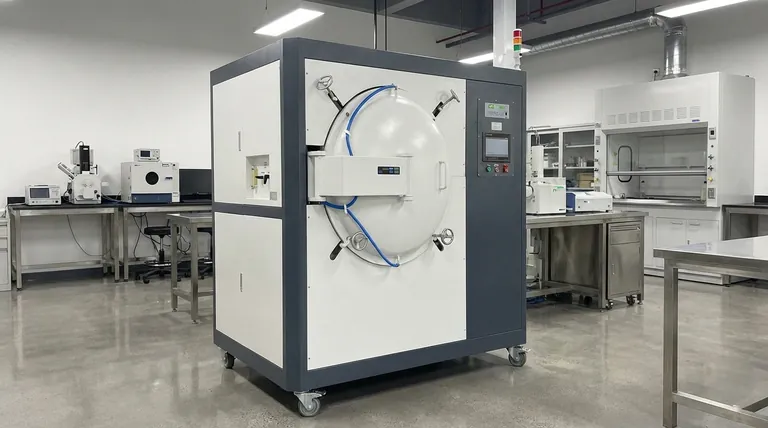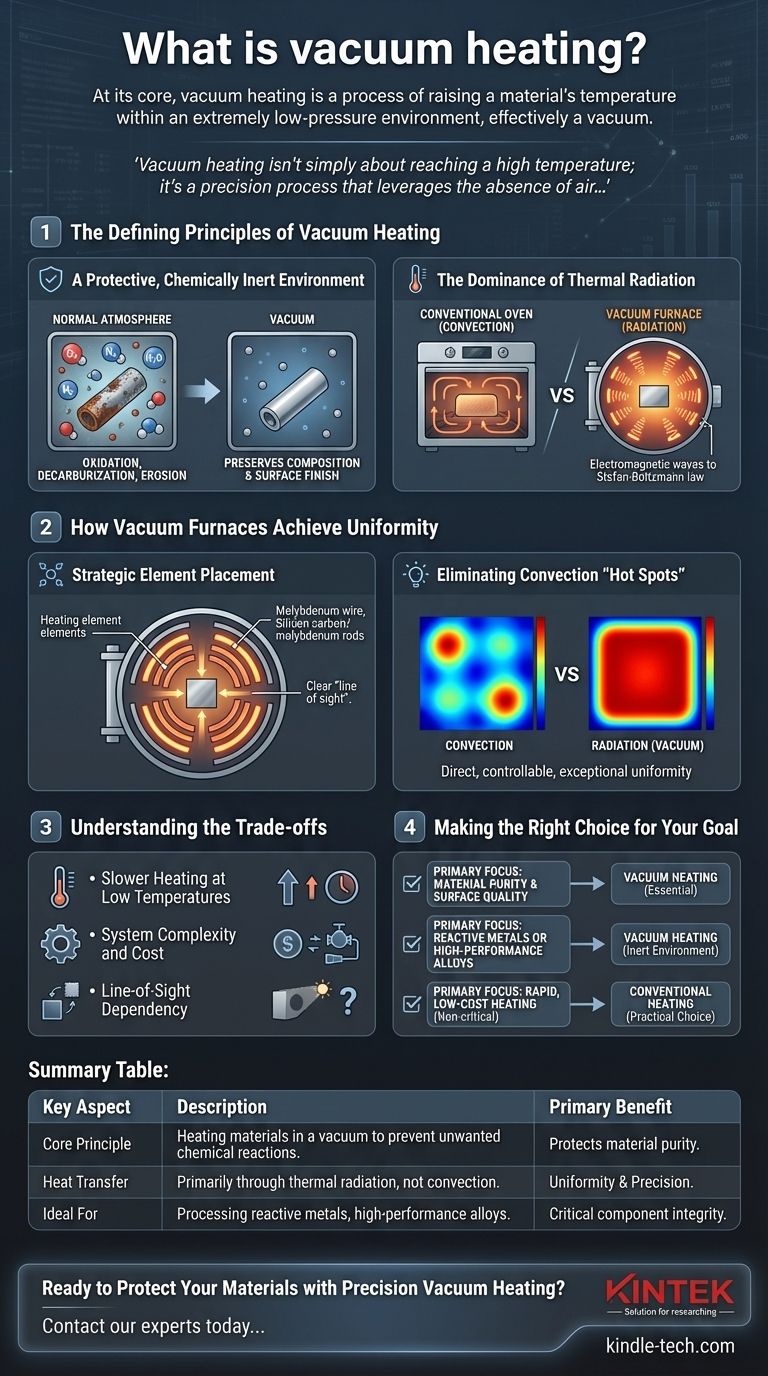At its core, vacuum heating is a process of raising a material's temperature within an extremely low-pressure environment, effectively a vacuum. This is done to prevent the unwanted chemical reactions, such as oxidation or decarburization, that occur when materials are heated in the presence of air. The absence of an atmosphere fundamentally changes how heat is transferred, relying on radiation instead of convection.
Vacuum heating isn't simply about reaching a high temperature; it's a precision process that leverages the absence of air. This unique environment protects a material's surface integrity and forces heat to transfer via radiation, a critical distinction from conventional heating methods.

The Defining Principles of Vacuum Heating
To understand vacuum heating, one must grasp the two characteristics that make it unique: the protective environment it creates and the method of heat transfer it employs.
A Protective, Chemically Inert Environment
In a normal atmosphere, heating metals and other materials invites chemical reactions. The oxygen, nitrogen, and moisture in the air react with the hot surface.
This leads to undesirable outcomes like oxidation (rusting), decarburization (loss of carbon from steel, making it weaker), and general surface erosion.
By removing virtually all of the air from the heating chamber, vacuum heating creates a chemically inert environment. This preserves the material's precise chemical composition and surface finish, which is critical for high-performance components.
The Dominance of Thermal Radiation
In a conventional oven, heat is primarily transferred by convection, where hot air circulates and heats the object. In a vacuum, there is no air to circulate.
Therefore, heat transfer must occur almost exclusively through thermal radiation. The furnace's heating elements emit energy as electromagnetic waves, which travel through the vacuum and are absorbed by the material, causing it to heat up.
This process is governed by the Stefan-Boltzmann law, which states that the energy radiated is proportional to the fourth power of the absolute temperature. This means that as temperatures rise, heat transfer becomes exponentially more efficient.
How Vacuum Furnaces Achieve Uniformity
The principles of vacuum heating directly influence the design of the furnaces that use this process. The goal is to deliver uniform radiative heat to the entire workpiece.
Strategic Element Placement
To ensure the material heats evenly from all sides, high-quality heating elements are arranged to surround the workpiece. These elements must provide a clear "line of sight" to all surfaces.
Materials like molybdenum wire, silicon carbon rods, or silicon molybdenum rods are commonly used. They are chosen for their ability to withstand extreme temperatures and radiate heat effectively and uniformly.
Eliminating Convection "Hot Spots"
A major advantage of radiation is predictability. Unlike convection currents, which can cause unpredictable hot and cold spots, radiative heating is more direct and controllable.
Proper furnace design ensures that all surfaces of the part receive an equal amount of radiative energy, leading to exceptional temperature uniformity throughout the material.
Understanding the Trade-offs
While powerful, vacuum heating is not the solution for every application. Its unique properties come with specific limitations.
Slower Heating at Low Temperatures
The efficiency of radiative heat transfer is highly dependent on temperature. At lower temperatures, the process is relatively slow and inefficient.
This means the initial "ramp-up" phase of vacuum heating can take longer than conventional methods that use convection.
System Complexity and Cost
Creating and maintaining a high vacuum is technically demanding. It requires robust, sealed chambers and powerful, multi-stage pumping systems.
This inherent complexity makes vacuum furnaces significantly more expensive to build, operate, and maintain compared to standard atmospheric furnaces.
Line-of-Sight Dependency
Because heat travels in straight lines via radiation, any part of the workpiece that is "shadowed" or doesn't have a direct line of sight to a heating element will heat much more slowly.
This presents a challenge for objects with highly complex geometries or internal cavities, requiring very careful furnace design and part placement to achieve uniformity.
Making the Right Choice for Your Goal
Deciding whether to use vacuum heating depends entirely on your material, your process, and your desired final outcome.
- If your primary focus is material purity and surface quality: Vacuum heating is essential, as it prevents the oxidation and contamination that are unavoidable in an air-filled furnace.
- If your primary focus is processing reactive metals or high-performance alloys: This method provides the necessary inert environment to heat these materials without compromising their specific properties.
- If your primary focus is rapid, low-cost heating for non-critical applications: Conventional convection or conduction heating is often a more practical and economical choice.
Ultimately, vacuum heating is a precision tool used when the integrity and performance of the final material are paramount.
Summary Table:
| Key Aspect | Description |
|---|---|
| Core Principle | Heating materials in a vacuum to prevent unwanted chemical reactions. |
| Heat Transfer | Primarily through thermal radiation, not convection. |
| Primary Benefit | Protects material purity, surface finish, and chemical composition. |
| Ideal For | Processing reactive metals, high-performance alloys, and critical components. |
Ready to Protect Your Materials with Precision Vacuum Heating?
If your processes demand superior material purity and surface integrity, KINTEK's advanced vacuum furnaces are the solution. We specialize in providing the precise, contamination-free heating environment that laboratories and high-tech manufacturers rely on for critical applications.
Contact our experts today to discuss how our lab equipment can enhance your results and ensure the quality of your high-performance materials.
Visual Guide

Related Products
- Vacuum Heat Treat Furnace with Ceramic Fiber Liner
- 2200 ℃ Graphite Vacuum Heat Treat Furnace
- Molybdenum Vacuum Heat Treat Furnace
- Vacuum Heat Treat and Molybdenum Wire Sintering Furnace for Vacuum Sintering
- Graphite Vacuum Furnace High Thermal Conductivity Film Graphitization Furnace
People Also Ask
- How to vacuum out a furnace? A Step-by-Step Guide to Safe DIY Maintenance
- What is a vacuum furnace used for? Unlock Purity in High-Temperature Processing
- What materials are used in a vacuum furnace? Selecting the Right Hot Zone for Your Process
- Why do you vacuum for heat treatment? Achieve Flawless, High-Performance Metal Components
- Can I vacuum the inside of my furnace? A Guide to Safe DIY Cleaning vs. Professional Service



















